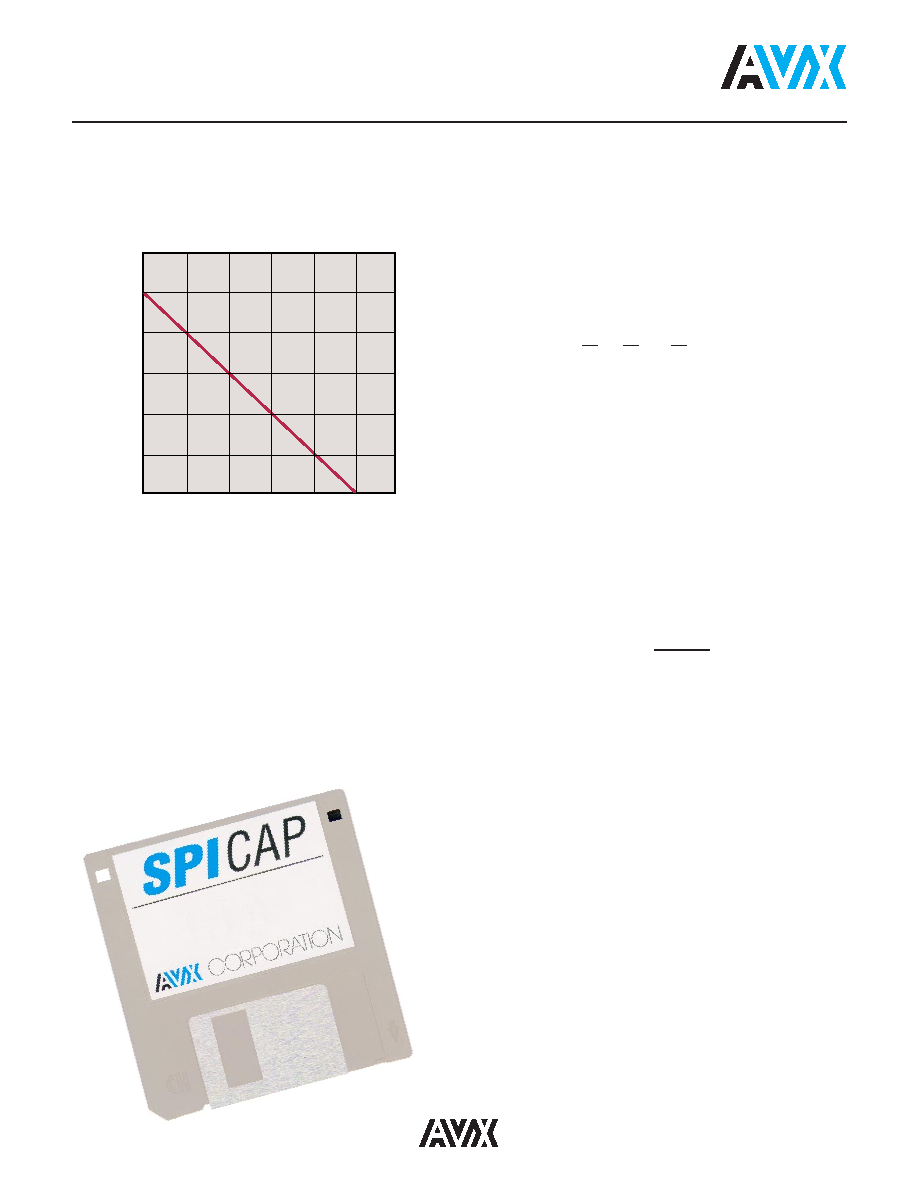- 您現(xiàn)在的位置:買賣IC網(wǎng) > PDF目錄24705 > 06035C222KAT2A KONDENSATOR 50V 2200PF 10ST PDF資料下載
參數(shù)資料
| 型號(hào): | 06035C222KAT2A |
| 英文描述: | KONDENSATOR 50V 2200PF 10ST |
| 中文描述: | KONDENSATOR 50V 2200PF 10ST |
| 文件頁數(shù): | 33/46頁 |
| 文件大小: | 659K |
| 代理商: | 06035C222KAT2A |
第1頁第2頁第3頁第4頁第5頁第6頁第7頁第8頁第9頁第10頁第11頁第12頁第13頁第14頁第15頁第16頁第17頁第18頁第19頁第20頁第21頁第22頁第23頁第24頁第25頁第26頁第27頁第28頁第29頁第30頁第31頁第32頁當(dāng)前第33頁第34頁第35頁第36頁第37頁第38頁第39頁第40頁第41頁第42頁第43頁第44頁第45頁第46頁

tends to de-age capacitors and is why re-reading of capac-
itance after 12 or 24 hours is allowed in military specifica-
tions after dielectric strength tests have been performed.
Effects of Frequency – Frequency affects capacitance
and impedance characteristics of capacitors. This effect is
much more pronounced in high dielectric constant ceramic
formulation that is low K formulations. AVX’s SpiCap soft-
ware generates impedance, ESR, series inductance, series
resonant frequency and capacitance all as functions of fre-
quency, temperature and DC bias for standard chip sizes
and styles. It is available free from AVX.
Effects of Mechanical Stress – High “K” dielectric
ceramic capacitors exhibit some low level piezoelectric
reactions under mechanical stress. As a general statement,
the piezoelectric output is higher, the higher the dielectric
constant of the ceramic. It is desirable to investigate this
effect before using high “K” dielectrics as coupling capaci-
tors in extremely low level applications.
Reliability – Historically ceramic capacitors have been one
of the most reliable types of capacitors in use today.
The approximate formula for the reliability of a ceramic
capacitor is:
L
o
=
V
t
X
T
t
Y
L
t
V
o
T
o
where
Lo = operating life
Tt = test temperature and
Lt = test life
To = operating temperature
Vt = test voltage
in °C
Vo = operating voltage
X,Y = see text
Historically for ceramic capacitors exponent X has been
considered as 3. The exponent Y for temperature effects
typically tends to run about 8.
A capacitor is a component which is capable of storing
electrical energy. It consists of two conductive plates (elec-
trodes) separated by insulating material which is called the
dielectric. A typical formula for determining capacitance is:
C =
.224 KA
t
C = capacitance (picofarads)
K = dielectric constant (Vacuum = 1)
A = area in square inches
t = separation between the plates in inches
(thickness of dielectric)
.224 = conversion constant
(.0884 for metric system in cm)
Capacitance – The standard unit of capacitance is the
farad. A capacitor has a capacitance of 1 farad when 1
coulomb charges it to 1 volt. One farad is a very large unit
and most capacitors have values in the micro (10-6), nano
(10-9) or pico (10-12) farad level.
Dielectric Constant – In the formula for capacitance given
above the dielectric constant of a vacuum is arbitrarily cho-
sen as the number 1. Dielectric constants of other materials
are then compared to the dielectric constant of a vacuum.
Dielectric Thickness – Capacitance is indirectly propor-
tional to the separation between electrodes. Lower voltage
requirements mean thinner dielectrics and greater capaci-
tance per volume.
Area – Capacitance is directly proportional to the area of
the electrodes. Since the other variables in the equation are
usually set by the performance desired, area is the easiest
parameter to modify to obtain a specific capacitance within
a material group.
38
1
10
100
1000 10,000 100,000
Hours
Capacitance
Change
Percent
+1.5
0
-1.5
-3.0
-4.5
-6.0
-7.5
Characteristic
Max. Aging Rate %/Decade
C0G (NP0)
X7R
Z5U
Y5V
None
2
3
5
Figure 6
Typical Curve of Aging Rate
X7R Dielectric
General Description
相關(guān)PDF資料 |
PDF描述 |
|---|---|
| 08051A100JAT2A | KONDENSATOR 10PF 100V 10ST |
| 08051A101JAT2A | KONDENSATOR 100PF 100V 10ST |
| 08051A220JAT2A | KONDENSATOR 22PF 100V 10ST |
| 08051A221JAT2A | KONDENSATOR 220PF 100V 10ST |
| 08051A330JAT2A | KONDENSATOR 33PF 100V 10ST |
相關(guān)代理商/技術(shù)參數(shù) |
參數(shù)描述 |
|---|---|
| 06035C222KAT2A/4K | 制造商:AVX Corporation 功能描述:CAP CER 2200PF 50V 10% X7R 0603 |
| 06035C222KAT4A | 功能描述:多層陶瓷電容器MLCC - SMD/SMT 50volts 2200pF 10% X7R RoHS:否 制造商:American Technical Ceramics (ATC) 電容:10 pF 容差:1 % 電壓額定值:250 V 溫度系數(shù)/代碼:C0G (NP0) 外殼代碼 - in:0505 外殼代碼 - mm:1414 工作溫度范圍:- 55 C to + 125 C 產(chǎn)品:Low ESR MLCCs 封裝:Reel |
| 06035C222KAT7A | 功能描述:多層陶瓷電容器MLCC - SMD/SMT 50volts 2200pF 10% X7R RoHS:否 制造商:American Technical Ceramics (ATC) 電容:10 pF 容差:1 % 電壓額定值:250 V 溫度系數(shù)/代碼:C0G (NP0) 外殼代碼 - in:0505 外殼代碼 - mm:1414 工作溫度范圍:- 55 C to + 125 C 產(chǎn)品:Low ESR MLCCs 封裝:Reel |
| 06035C222KATN-YAG | 制造商:Yageo Corporation 功能描述: |
| 06035C222KAZ2A | 功能描述:多層陶瓷電容器MLCC - SMD/SMT 50volts 2200pF 10% X7R RoHS:否 制造商:American Technical Ceramics (ATC) 電容:10 pF 容差:1 % 電壓額定值:250 V 溫度系數(shù)/代碼:C0G (NP0) 外殼代碼 - in:0505 外殼代碼 - mm:1414 工作溫度范圍:- 55 C to + 125 C 產(chǎn)品:Low ESR MLCCs 封裝:Reel |
發(fā)布緊急采購,3分鐘左右您將得到回復(fù)。